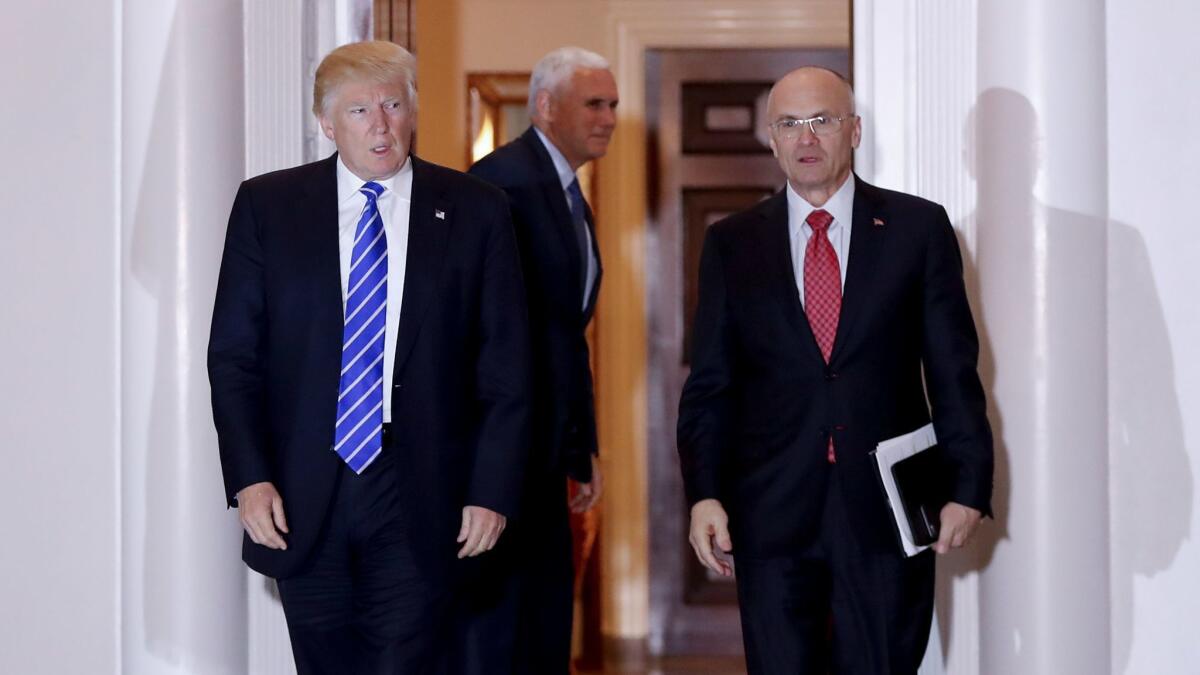Opinion: Labor faces strong headwind from a Trump administration — and maybe that’s just the jolt workers need

President-elect Donald Trump and Andy Puzder, nominee for secretary of Labor, leave the clubhouse of a Trump golf course in New Jersey.
- Share via
The last year has been invigorating for part of the labor movement as the “Fight for $15” campaign progressed rapidly from pie in the sky to, in some places at least, reality, and federal labor protections were expanded.
Get ready for the snapback.
President-elect Donald J. Trump could pose the biggest threat to American workers since President Reagan, who similarly won support from working-class Americans despite policies that undercut their ability to work together for higher wages and better working conditions.
Trump’s own history with labor stands as a warning, from hiring and underpaying undocumented workers to clear the site for his Trump Tower in Manhattan, to anti-union stances at some of his hotel properties. And his nominee to run the Labor Department, Andrew F. Puzder of fast-food conglomerate CKE Restaurants (Hardee’s, Carl’s Jr.), opposes minimum-wage hikes, the Obama administration’s recent expansion of overtime protections and other elements enhancing workers’ rights.
Maybe a profoundly anti-worker Trump administration is just what American labor needs — a galvanizing force, and a defined target.
If the Senate confirms the appointment, which seems likely, Pruzder will soon be in charge of enforcing the very things he opposes. Under federal regulatory procedures, it will take some work, but Puzder could eventually undo many of the gains achieved under Obama, and roll back protections even further.
More ominously, the National Labor Relations Board is in a similarly fraught position. The board, which adjudicates complaints about violations of labor laws, is a five-seat panel that traditionally swings to a Democratic or Republican majority depending on who is in the White House. Trump will inherit a board, though, with only three sitting members, a 2-1 Democratic majority. The term of the sole Republican, Obama-appointee Philip Miscimarra, expires in late 2017, as does that of general counsel Richard F. Griffin Jr. That means Trump will be in a position to radically reshape the NLRB with three board appointees and a new general counsel in his first year.
What’s at risk? Among other things, the board’s recent “quickie” election rule, which speeds up the calendar for union-recognition campaigns and reduces companies’ ability to fight off the efforts through compulsory meetings and other heavy-handed tactics, including cynical use of legal challenges to delay the process. The NLRB has also been moving to make franchising corporations such as McDonald’s share responsibility for the treatment of workers by franchisees, an effort that seems likely to fade away with a quantum shift in outlook under a Trump NLRB.
But the biggest threat could be to unions themselves. For years, anti-union activists have pushed “right to work” laws — barring compulsory payment of union dues to cover the costs of bargaining and maintaining contracts — at state levels with varying degrees of success. But there’s also a movement at the federal level, which could get enough support within Congress and the Trump administration to pass.
That wouldn’t be a death knell for unions, but it would certainly make an already difficult situation even worse.
So how dark is the future for labor? It’s hard to say here on the 80th anniversary of the start of the famous Flint sit-down strike — which ushered in the rise of organized labor and, by extension, the rise of the American middle class. It was a difficult fight, one that took deep personal sacrifices of the workers themselves as they fought for their futures, and for the common good.
So maybe a profoundly anti-worker Trump administration is just what American labor needs — a galvanizing force, and a defined target. And by expanding and building on the successful fights for higher minimum wages, labor can remind remind workers that the more they fight together, the more they gain together.
Follow my posts and retweets at @smartelle on Twitter
A cure for the common opinion
Get thought-provoking perspectives with our weekly newsletter.
You may occasionally receive promotional content from the Los Angeles Times.







